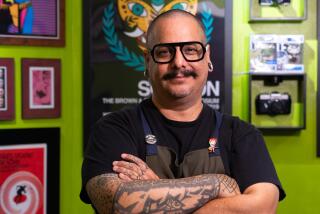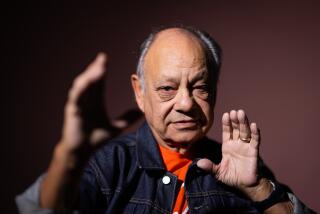âRomeroâ Pays Tribute to Chicano View
During the early years of the Chicano movement, in the â70s, Frank Romero established a reputation as one of its art heroes.
He belonged to the first group of local contemporary Latino artists to crack the hallowed halls of the Los Angeles County Museum of Art in the 1974 exhibition âLos Four.â Their breakthrough was greeted with accusations that they had sold out to the establishment. Sometimes nothing fails like success.
Now Cal State L.A. honors the artist with the exhibition âFrank Romero: Urban Iconography/Iconografia Urbana.â Nicely installed in the Luckman Fine Arts Gallery, it looks at L.A. from a Chicano perspective. The motifs are unmistakable: lowriders, cactus, skulls and flaming hearts all rendered in a cartoon graffiti style typical of the barrio.
Yet itâs a perspective tinged with detectably mixed feelings. These images are insufficiently recognized as also being American, informed by pop culture and international Modernism. Guest curator Susana Bautistaâs catalog essay notes perceptively that the American-born Romero thought of himself as Mexican until he made his first visit there in 1969. Despite his mustache and a zest for the cuisine, he was taunted by indigenous Mexicans for his limited Spanish. On his return to L.A., Bautista writes, he âbecame a Chicano, kicking and screaming.â
Her point, I think, is that no one--especially an artist--likes being turned into a cliche. It follows that when stereotyping is self-inflicted, it takes a certain irony to preserve the nuances of real self-hood. Inevitably, this will affect the feel of an artistâs product.
The exhibition, which includes about 70 works, is billed as a 30-year survey. I saw only one painting--a still life of 1963--earlier than 1981. Itâs no big deal, but such fudging suggests a wish that things seem a bit grander than they actually are.
Romeroâs art comes on strong. Master of many media from drawing and painting to ceramics and sculpture, he projects the air of a self-confident virtuoso.
A significant fraction of his reputation is based on big murals. He often works large, as in âFeliz Union,â a life-size tableau of painted wood cut-out wedding figures near their honeymoon getaway car. He comes on flashy in neon works like âFloral Drive In,â a relief of funky autos watching a larger-than-life Hollywood kiss. He takes on man-size subject matter in paintings about the Chicano moratorium of 1970, when Times columnist Ruben Salazar was killed by a police projectile.
The work is always technically deft and produces the appropriate response. Curiously, though, one is frequently left wondering how the artist actually feels. Despite an Expressionist style, thereâs an odd sense of aloofness signaled by the fact that Romero often quite literally views his images from a kind of distant middle-ground.
There are notable exceptions. âThe Ghost of Evergreen Cemeteryâ is authentically spooky. The mini-mural âPleasantvilleâ (its label identifies a collaborator in Alfredo de Batuc) is a nostalgic look back at â50s L.A. Romero signals the lurking repression of the era with burning books flying to heaven, but the details of kids making out in convertibles drip with more convincing affection. A catalog essay by historian Margarita Nieto illuminates the work.
It almost seems that the smaller Romero works, the more openly he expresses sensitivity. His photograph of a pubescent girl named Ninny aches with forbidden longing. His grandfather is represented as a handsome patriarch, beloved despite overweening pride.
A table of wheeled toys recalls pre-Columbian prototypes but Romero--evidently a true multiculturalist--bases them on his collection of German playthings. âAnne Leaving Texasâ shows a woman in a rag-top embarking with a house trailer. It has to be a portrait of someone the artist cares about.
In Spanish, âanimoâ means spirit. Romero makes a bilingual pun using the word to describe images of animals. Clearly a homage to Picasso, these Minotaur and equine figures capture some of the ferocity of âGuernica.â
One seemingly anomalous series simply presents various slabs of adobe--the common clay ordinary Mexicans transform into the warmth of home. These pieces speak volumes about the essential earthiness of Romeroâs art.
* Cal State L.A., Luckman Fine Arts Gallery; through June 22, closed Fridays and Sundays, (213) 343-6604.
More to Read
The biggest entertainment stories
Get our big stories about Hollywood, film, television, music, arts, culture and more right in your inbox as soon as they publish.
You may occasionally receive promotional content from the Los Angeles Times.










